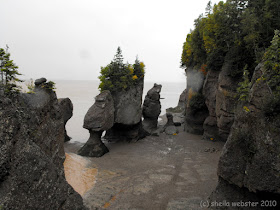We were spending some time in Moncton , New Brunswick
Pathway to Hopewell Rocks, NB
We headed out to the Bay of Fundy ’s famous Hopewell Rocks also called the Flowerpot Rocks with our rain gear. There were few visitors in this rain, can’t understand that (: and we trudge through the gates and down the empty path to see the famous rocks.

Treeroots on path to Hopewell Rocks, NB
I started to believe we were in a Jurassic Park
Hopewell Rocks, New Brunswick
It isn’t too far a walk to the first viewpoint of the Hopewell Rocks. Even in the rain, this was a great sight to see. There are story boards to explain some of the phenomenon of the highest tides in the world as well as park guides who are eager to tell you all about it.

Huge formations at Hopewell Rocks, NB

Seaweed covered formations at Hopewell Rocks, NB

Flowerpot rock formations at Hopewell Rocks, NB

Huge formations at Hopewell Rocks, NB
We didn’t have a lot of time as the tide was coming in and once it gets to a certain point, the park guides are quick to tell you to leave the beach. The tide moves very quickly and it isn’t worth taking chances getting caught down there so we were very limited in our beach walk. There is a long staircase that takes you down to the beach.

Seaweed covered formations at Hopewell Rocks, NB
These rocks are huge and until you get down there, you do not realize how huge they really are. Wait a minute, is that the foot of a prehistoric mammoth? Maybe we really are in Jurassic Park! This is actually a rock formation covered in seaweed.
Lovers Arch at Hopewell Rocks, New Brunswick
These rocks are millions of years old and the shapes are caused by the tidal erosion. This erosion causes the base to weaken and parts will slide off yearly. There are ongoing changes due to the freezing and thawing in the spring, and this causes the cracks to widen. There is no way of knowing how long but they say it could take hundreds or even thousands of years to be gone, depending on how unbalanced they become.
Unique rock formations at Hopewell Rocks, NB
They do get the world’s highest tide here at 14m (46 ft) and higher. We know that the sun and moon’s gravitational forces affect the tides but the shape of the Bay of Fundy plays a big role in this as well. Hopewell Rocks are at the head of the bay which is shaped like a funnel so gets the full effect of the high tides with that combination.

Flowerpot rock formations at Hopewell Rocks, NB
They say there is one hundred billion ton of water moving in and out of the bay twice every 25 hours. Yes, that really is a ‘billion’ and not a typo, and that is a lot of water.
Be sure to check the website for the tide tables before you go, so that you have time to see and enjoy all of the Hopewell Rocks beach and park. And don’t wait for the rain to stop to get a visit there, even in the rain it is worth a visit to the Hopewell Rocks.



